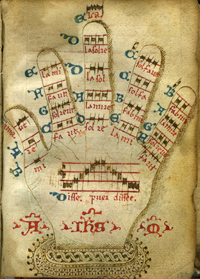For many of us, the story of Guido d’ Arezzo was made legend while in music school. Fr. Klarmann, in his book Gregorian Chant, tells a very interesting tale that reminds us again that monastic life can be quite exciting, as is the history of chant!
“One of the greatest incentives to the spread of the chant was invented by a companion to St. Bernard, a monk named Guido. He maintained strong views about the chant and thereby incurred the unpopularity of his brother monks. He was sent, or possibly went of his own accord under the duress of petty jealousy, from the monastery of St. Maurus near Paris to Pomposa in Italy. The same fate of an ambitious musician met him there. He then went to a monastery near Arezzo and there, apparently, he found peace. He set himself to the task of placing the neums on horizontal lines, one known and designated as the ‘do-line’, the other as the ‘fa-line.’ He later added another line between these two and still another below, all of which formed the staff of four lines which we have today. The fifth line of our modern staff was not added until the 17th century. The Pope, John XIX, was elated at the invention for in it he saw the means of perpetuating and propagating the chant melodies without entrusting them to fickle memories. He summoned Guido to Rome to teach his discovery to others. Because of ill health, Guido had soon to leave the city. The monks who had formerly brought about his dismissal from their monastery now welcomed his return (!) But Guido decided upon Arezzo and remained there until his death. It was he who gave the notes of the scale their sol-fa names.” (pp.125-126)
The image with today’s blog is the way Guido developed to teach his system by using the joints in the hand for the various note names.
Enjoy!
